Main menu
Common skin conditions

NEWS
Join DermNet PRO
Read more
Quick links
Vascular malformations associated with steal phenomena — extra information
Vascular malformations associated with steal phenomena
Author: Dr Caroline Mahon, Dermatology Registrar, Green Lane Hospital, Auckland, New Zealand, 2013.
Introduction
Arteriovenous malformations
AVM-related syndromes
Dialysis-associated steal syndrome
Bier spots
Naevus anaemicus
Phakomatosis pigmentovascularis
What are blood steal phenomena?
Blood steal phenomena occur in vascular malformations when there is a significant difference in the volume and rate of blood flow in a localised area compared to surrounding tissue. It is due to disorders of blood vessel structure and function.
In large vessels:
- Disordered blood flow may damage surrounding tissues.
- Excessive blood flow may cause blood vessels to rupture and bleed. Bleeding in the brain can be catastrophic, causing seizures, collapse and death.
- Excessive blood flow to one limb can lead to heart failure.
In very small blood vessels (capillaries), the steal phenomenon is not dangerous.
Arteriovenous malformations
An arteriovenous malformation (AVM) consists of a localised mass of blood vessels in which there is a direct connection between arteries (supplying oxygenated blood from the heart) and veins (returning deoxygenated blood to the heart). The usual intervening capillary network between arteries and veins is missing.
Capillaries are very small blood vessels and are responsible for blood supply to the skin and subcutaneous tissues.
The resistance to blood flowing through vessels in an AVM is lower than through normal capillaries in surrounding skin, so the volume of blood through the AVM increases over time. The AVM siphons blood from nearby normal vessels, which may not supply enough oxygen to surrounding tissues. The reduced blood flow is often referred to as ‘blood steal’ or the ‘blood steal phenomenon’.
Feeding and draining vessels of an AVM often lose their elasticity and develop weak areas or outpouching of the blood vessel walls (aneurysms), which can rupture and lead to catastrophic bleeding.
In most cases, the heart adapts to a gradual rise in blood flow through an AVM. Heart failure due to AVM is rare, affecting 1 to 2% of cases where there is raised cardiac output from excess blood flow through an extensive AVM on a limb.
Arteriovenous malformations (AVM) are present at birth in 40 to 60% of cases. They first appear in childhood in 25% of cases, but may also arise later in life (during adolescence in 10% and adulthood in 25%). Males and females are affected in equal numbers.
An AVM can occur in any body tissue. AVMs are present in the head and neck in two-thirds of cases. AVMs of the limbs, trunk, chest and abdominal cavities are less common.
Arteriovenous malformations of the skin and soft tissues
AVMs are usually first noticed at birth as pink or bluish staining of the skin. As the child grows, the stain may deepen in colour and bulkiness may develop beneath the stain. A throbbing sensation may be felt in the overlying skin. Turbulence in the blood flow within the AVM may be audible using a stethoscope; the sound is known as a bruit. If an AVM occurs in the lower limb, purple-brown lumps may appear in the skin, which mimics Kaposi sarcoma.
If the AVM enters a progressive phase (most commonly in adolescence), ‘blood steal’ skin changes may develop. The overlying skin and skin beyond the AVM may necrose (die) with painful ulceration and bleeding.
AVM-related syndromes
Hereditary haemorrhagic telangiectasia
Hereditary haemorrhagic telangiectasia (HHT) is also known as Osler-Weber-Rendu syndrome. It is characterised by telangiectases of the skin, the nasal and oral cavities, and arteriovenous malformations (AVMs) in the lungs, brain, or other organs.
Capillary malformation-arteriovenous malformation
In capillary malformation-arteriovenous malformation (CM-AVM), there are multiple capillary malformations in the skin associated with AVMs. The capillary malformations present as small pink to red stains with a surrounding halo of pale skin. AVMs most often occur in the skin, soft tissues, muscle, bone or within the brain.
Cobb syndrome
Cobb syndrome is a rare disorder in which angiomas or arteriovenous malformations (AVM) of the spinal cord are associated with vascular lesions in the skin of the relevant dermatome. This is the skin supplied by the nerves originating from within the spinal AVM.
Sturge-Weber syndrome
In Sturge-Weber syndrome (SWS), a port-wine stain or superficial blood vessels (capillary vascular malformations) are present at birth, usually on one side of the face. This syndrome is due to somatic mutations in the gene GNAQ and may be associated with blood vessel malformations of the eye and the brain on the same side. Children may develop glaucoma or increased pressure in the globe of the eye. This may cause blindness. Blood vessel malformations in the brain may result in seizures or developmental delay.
Wyburn-Mason Syndrome
Wyburn-Mason syndrome is also known as Bonnet-Dechaume-Blanc Syndrome and is a rare condition characterized by AVMs in the brain and the retina of the eye. AVMs may also occur at other body sites. Some children have port-wine stains on one side or in the midline of the face.
Klippel-Trenaunay syndrome
In Klippel-Trenaunay syndrome, blood vessel and lymph channel abnormalities involve a whole arm or leg. The syndrome most often presents with port-wine stain, varicose veins, overgrowth of the soft tissues and bone, and disordered lymph system drainage of the affected limb.
Parkes-Weber syndrome
Parkes-Weber syndrome (PWS) differs from Klippel-Trenaunay syndrome (KTS) in that the former is a high-flow condition with arteriovenous fistulae and therefore may be complicated by heart failure, unlike KTS which is low-flow. Some forms of PWS are associated with changes in the RASA-1 gene and are inherited in an autosomal dominant manner.
Dialysis-associated steal syndrome
Dialysis-associated steal syndrome is also known as distal hypoperfusion ischaemic syndrome. The steal syndrome describes arterial insufficiency in the skin and soft tissues of the upper limb beyond a hemodialysis fistula.
Haemodialysis is the process by which blood is diverted via the fistula to a hemodialysis machine, which externally performs the function of the patient's failed kidneys. A patient with kidney failure that requires haemodialysis has a surgical procedure to connect a large artery and vein, forming an arteriovenous fistula.
The fistula is usually formed in the arm, either at the elbow or the wrist and directs blood away from the forearm or hand. The low resistance of the fistula to blood flow reverses the direction of the blood flow in the artery downstream, leading to ‘blood steal’.
The steal phenomenon is common in dialysis patients but rarely leads to symptoms. Tissue damage is prevented by two main mechanisms: compensatory dilatation of the downstream arteries, and collateral blood flow through alternative routes. If these compensatory mechanisms fail, tissue death in the fingertips and the hand may result.
Risk factors for dialysis-associated steal syndrome include diabetes mellitus, peripheral arterial disease, patient age greater than 60 years, upper arm versus lower arm fistula, and multiple surgeries to the same limb.
Bier spots
Bier spots were originally described in 1898 and have also been called physiologic anaemic macules, angiospastic macules, and exaggerated physiologic mottling of the skin.
Bier spots affect young adults, especially males. The reason for this is unknown. There are approximately 70 reports of patients with Bier spots in the medical literature.
Bier spots are transient, small pale macules with an irregular border and surrounding blanching halo of erythema (redness). They are most common on arms and legs, and become less visible or disappear on raising the affected limb.
The areas of pale skin are thought to be due to raised pressure constricting small veins (venous hypertension), relative to the normal-appearing surrounding skin.
Bier spots usually affect otherwise healthy individuals. However, sometimes they are due to an increase in blood viscosity in systemic diseases such as cryoglobulinaemia or polycythaemia. They have also been reported in pregnancy. There has been a report of Bier spots in a patient with scleroderma renal crisis.
Bier spots may mimic pale patches due to pityriasis versicolor, a fungal infection, naevus depigmentosus (achromic naevus), postinflammatory hypopigmentation, vitiligo or naevus anaemicus (see below).
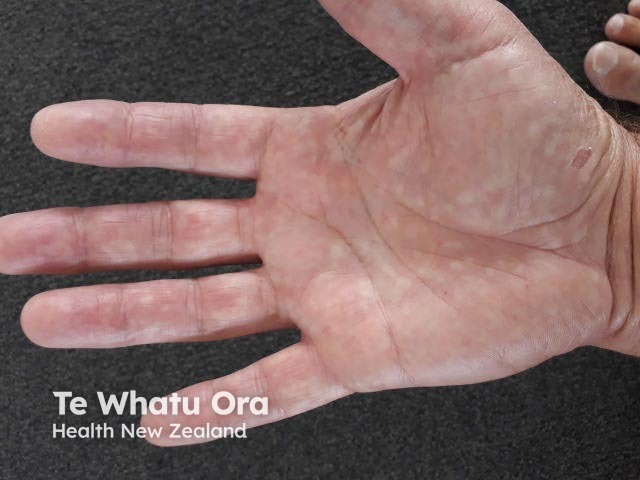
Bier spots
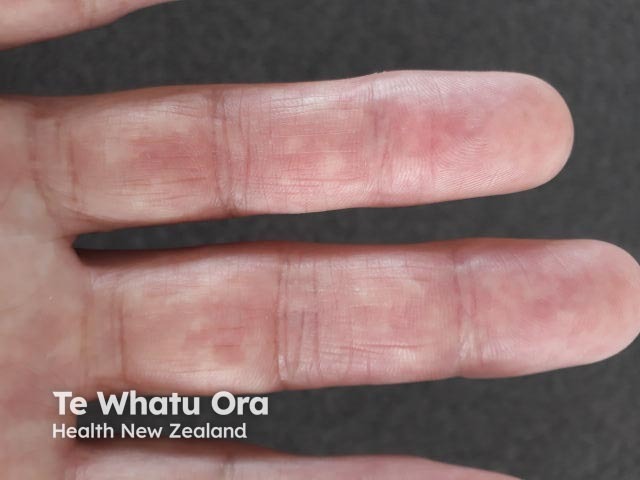
Bier spots
Naevus anaemicus
Naevus anaemicus is a localised collection of abnormal blood vessels present at birth, but it may not be visible until a few months of age. It is usually a single, asymptomatic pale patch that does not become reddened on rubbing. A mosaic form with multiple anaemic naevi can appear reticulate, or net-like. Naevus anaemicus most often affects the trunk but can occur at any body site.
Naevus anaemicus can be confused with other pale lesions on the skin such as naevus depigmentosus (achromic naevus), and vitiligo.
Abnormal blood vessels within the naevus have increased sensitivity to adrenaline and noradrenaline (circulating catecholamines). Catecholamines lead to blood vessel constriction through their interaction with α-adrenergic receptors. A deficient function of α-adrenergic receptors in the muscular walls of the blood vessels and increased reactivity of α-adrenergic receptors may lead to permanent blood vessel constriction within a naevus anaemicus.
Naevus anaemicus is usually an incidental finding on skin examination. There have been reports of naevus anaemicus in patients with neurofibromatosis type I and in a rare syndrome called phakomatosis pigmentovascularis (see below).
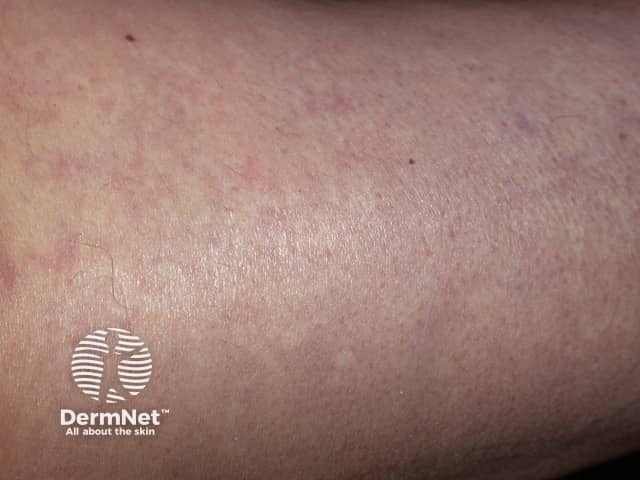
Naevus anaemicus

Naevus anaemicus
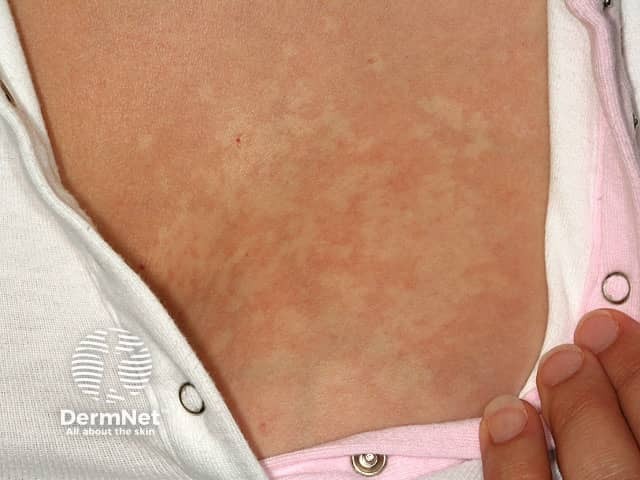
Naevus anaemicus
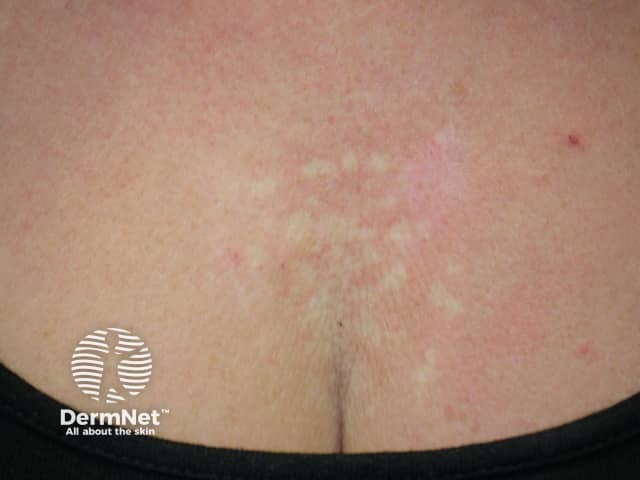
Naevus anaemicus
Phakomatosis pigmentovascularis
Phakomatosis pigmentovascularis (PPV) is a rare syndrome characterised by the association of a vascular naevus, usually a capillary naevus (naevus flammeus or port-wine stain), with an extensive pigmented naevus, most commonly Mongolian spot or blue/grey oculocutaneous melanocytosis (naevus of Ota).
References
- Garzon M, Huang J, Enjolras O, Frieden I. Vascular malformations: Part I. J Am Acad Dermatol. 2007 Mar;56(3):353–70. PubMed
- Garzon M, Huang J, Enjolras O, Frieden I. Vascular malformations: Part II: Associated syndromes. J Am Acad Dermatol. 2007;56(4):541–64. PubMed
- Malik J, Tuka V, Kasalova Z, Chytilova E, Slavikova M, Peyrot I, Boulinguez S, et al. Understanding the dialysis access steal syndrome. A review of the aetiologies, diagnosis, prevention and treatment strategies. J Vasc Access 2008;9(3):155–66. PubMed
- Ahkami RN, Schwartz RA. Nevus anemicus. Dermatology. 1999;198(4):327–9. PubMed
- Katugampola GA, Lanigan SW. The clinical spectrum of naevus anaemicus and its association with port wine stains: report of 15 cases and a review of the literature. Br J Dermatol. 1996 Feb;134(2):292–5. PubMed
- Fan YM, Yang YP, Li W, et al. Bier spots: six case reports. J Am Acad Dermatol. 2009;61:e11–2. PubMed
- Binois R, Galliot C, Audia S, et al. Multiple anaemic macules and diffuse erythrocyanosis revealing mixed cryoglobulinaemia. Eur J Dermatol. 2011;21:269–70. PubMed
- Sparsa A, et al. Bier’s white spots associated with scleroderma renal crisis. Clin Exp Dermatol. 2007; 32:165–7. PubMed
- Schoenlaub P, Dupré D, Redon JY, Plantin P. Numerous and large Bier's spot associated with pregnancy. Eur J Dermatol. 1999 Apr-May;9(3):230–1. PubMed
On DermNet
- Capillary vascular malformation
- Epidermal naevus syndromes
- Naevus anaemicus
- Phakomatosis pigmentovascularis
Other websites
- The Hemangioma and Vascular Birthmarks Foundation
- Sturge-Weber Foundation
- The National Organization of Vascular Anomalies
- Sturge-Weber Foundation (Canada) Inc.
- Sturge-Weber Syndrome Community
- Sturge-Weber Syndrome Community Canada
- Vascular Birthmarks — British Association of Dermatologists
- Medscape References:
